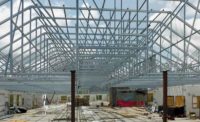“The project looked daunting at first,” says Dean Lessei, truss designer at Cascade. “So, I poured myself into the designs and pictured how it would come out.”
The project is a three-story, 67-unit assisted living center in Madison, Wis. It’s being built by PDC Midwest Inc., an award-winning, Hartland, Wis.-based design-build firm that specializes in senior living communities.
“Our typical building is 27,000 square-feet. This one is 67,000 square-feet,” says Jim Hirsch, construction manager at PDC Midwest “It’s almost three times the size of our normal project.”
How did cold-formed steel trusses and a talented team solve special demands to create a distinctive residence for seniors?
175 Truss Profiles
While PDC Midwest and Cascade have worked together for years, this project was large and had special requirements. The residence is meant to stand out among similar assisted living centers in the area.
“The facility has many exterior planes and multiple gables to break up an otherwise overwhelming roof mass,” says Tim Einwalter, ALA, project architect at PDC Midwest. “The TrusSteel system from Alpine provides a great deal of design flexibility and enhances the building’s overall appearance.”
To accommodate open and expansive interiors with minimal bearing walls, the project’s architects and engineers needed trusses to span long distances. The design also called for a custom catwalk in the attic. The catwalk, Einwalter says, was required by the municipality, since the trusses would run 4 feet-on-center. That distance would be too much for maintenance personnel to have to leap, truss to truss, in order to make their attic inspections.
Besides the catwalk, Lessei and Cascade truss technician Charles Kies incorporated the project’s vaulted and tray ceilings into the truss designs. They also gave special care to engineer trusses that would save money over the course of framing and finishing the job.
The catwalk, especially, required precision thinking in order to execute the design properly.
“We framed an open, 3-foot-wide area almost 7 feet tall, and it’s not triangulated,” Kies says. “Un-triangulating the truss design threw off the dynamics of the load transfers.”
Designing the Catwalk
Lessei and Kies designed the catwalk to run within the truss profiles above a notched or hat area to house some of the building’s mechanical systems. TrusSteel cold-formed steel trusses have a wide flange, so this feature made for an ideal substrate for the catwalk. Other cold-formed steel truss systems on the market have a much narrower flange.
“It’s an unusual design,” says Einwalter. “They raised the bottom chord of the truss at midspan—not the easiest thing to do structurally—but it worked. It was perfect for the HVAC, plumbing and sprinkler pipe.”
The raised hat area brought HVAC and water lines out of the cold space of the attic and eliminated the step of having to insulate the ductwork.
“Most of the time, a catwalk would sit directly on our bottom chord. In this case, the catwalk platform is raised 2 feet,” says Kies. “I started with a common truss profile and referenced it in our software as I worked out each truss. I was able to do the engineering quickly, but also carefully.”
Kies has been working on cold-formed steel trusses at Cascade for 15 years. He also hobby farms—125 acres of corn, hay, sheep and cattle—so he’s used to having a full plate.
“There were 175 unique truss profiles on this job,” says Kies. “I had to make sure the web members were uniform and lined up across the building. We wanted the trusses to be installer-friendly. We also wanted them to assemble efficiently on our production floor.”
Clean Truss Job
PDC Midwest’s Hirsch says the Madison assisted living center project is a success.
“It’s one of the first jobs I’ve done where I didn’t have many truss issues,” says Hirsch. “Sure, we had some ‘tweaking,’ which had nothing to do with the truss designs, but were due to things that came up in the field. But they were easy to modify, and it went together well. It’s one of the cleanest truss jobs I’ve ever done.”
Lessei and Kies believe a great truss product and collaboration between PDC Midwest and Cascade proved to be beneficial.
“What distinguishes Cascade is our attention to detail and thoroughness,” says Lessei, who has been at Cascade Mfg. Co. for 13 years. “We put heel details and section-cut details into our plans just to help our installers. You don’t see that with other truss suppliers.”
Project Details
Assisted living center, Madison, Wis.
67,000 square-feet, 67 units (1 bedroom, 2 bedroom and studio units)
Completed in spring 2015
Construction Team
General contractor: PDC Midwest, Hartland, Wis.
Structural engineer: Ambrose Engineering, Cedarburg, Wis.
Truss manufacturer: Cascade Mfg Co, Cascade, Iowa
Framing subcontractor: Suburban Drywall, Waukesha, Wis.
Roof
Corrugated deck with plywood sheathing and shingles
TrusSteel cold-formed steel-framed trusses with an attic walkway and notched area to accommodate mechanical systems
“The project looked daunting at first,” says Dean Lessei, truss designer at Cascade. “So, I poured myself into the designs and pictured how it would come out.”
The project is a three-story, 67-unit assisted living center in Madison, Wis. It’s being built by PDC Midwest Inc., an award-winning, Hartland, Wis.-based design-build firm that specializes in senior living communities.
“Our typical building is 27,000 square-feet. This one is 67,000 square-feet,” says Jim Hirsch, construction manager at PDC Midwest “It’s almost three times the size of our normal project.”
How did cold-formed steel trusses and a talented team solve special demands to create a distinctive residence for seniors?
175 Truss Profiles
While PDC Midwest and Cascade have worked together for years, this project was large and had special requirements. The residence is meant to stand out among similar assisted living centers in the area.
“The facility has many exterior planes and multiple gables to break up an otherwise overwhelming roof mass,” says Tim Einwalter, ALA, project architect at PDC Midwest. “The TrusSteel system from Alpine provides a great deal of design flexibility and enhances the building’s overall appearance.”
To accommodate open and expansive interiors with minimal bearing walls, the project’s architects and engineers needed trusses to span long distances. The design also called for a custom catwalk in the attic. The catwalk, Einwalter says, was required by the municipality, since the trusses would run 4 feet-on-center. That distance would be too much for maintenance personnel to have to leap, truss to truss, in order to make their attic inspections.
Besides the catwalk, Lessei and Cascade truss technician Charles Kies incorporated the project’s vaulted and tray ceilings into the truss designs. They also gave special care to engineer trusses that would save money over the course of framing and finishing the job.
The catwalk, especially, required precision thinking in order to execute the design properly.
“We framed an open, 3-foot-wide area almost 7 feet tall, and it’s not triangulated,” Kies says. “Un-triangulating the truss design threw off the dynamics of the load transfers.”
Designing the Catwalk
Lessei and Kies designed the catwalk to run within the truss profiles above a notched or hat area to house some of the building’s mechanical systems. TrusSteel cold-formed steel trusses have a wide flange, so this feature made for an ideal substrate for the catwalk. Other cold-formed steel truss systems on the market have a much narrower flange.
“It’s an unusual design,” says Einwalter. “They raised the bottom chord of the truss at midspan—not the easiest thing to do structurally—but it worked. It was perfect for the HVAC, plumbing and sprinkler pipe.”
The raised hat area brought HVAC and water lines out of the cold space of the attic and eliminated the step of having to insulate the ductwork.
“Most of the time, a catwalk would sit directly on our bottom chord. In this case, the catwalk platform is raised 2 feet,” says Kies. “I started with a common truss profile and referenced it in our software as I worked out each truss. I was able to do the engineering quickly, but also carefully.”
Kies has been working on cold-formed steel trusses at Cascade for 15 years. He also hobby farms—125 acres of corn, hay, sheep and cattle—so he’s used to having a full plate.
“There were 175 unique truss profiles on this job,” says Kies. “I had to make sure the web members were uniform and lined up across the building. We wanted the trusses to be installer-friendly. We also wanted them to assemble efficiently on our production floor.”
Clean Truss Job
PDC Midwest’s Hirsch says the Madison assisted living center project is a success.
“It’s one of the first jobs I’ve done where I didn’t have many truss issues,” says Hirsch. “Sure, we had some ‘tweaking,’ which had nothing to do with the truss designs, but were due to things that came up in the field. But they were easy to modify, and it went together well. It’s one of the cleanest truss jobs I’ve ever done.”
Lessei and Kies believe a great truss product and collaboration between PDC Midwest and Cascade proved to be beneficial.
“What distinguishes Cascade is our attention to detail and thoroughness,” says Lessei, who has been at Cascade Mfg. Co. for 13 years. “We put heel details and section-cut details into our plans just to help our installers. You don’t see that with other truss suppliers.”










